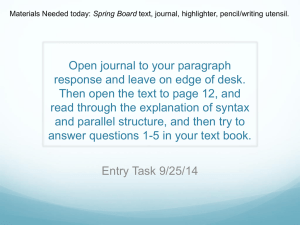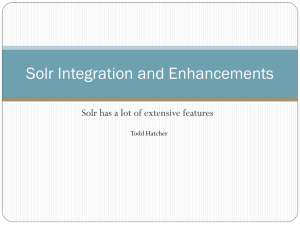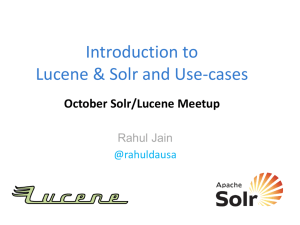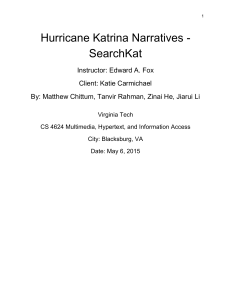Grammar-based suggestion engine with keyword search
advertisement
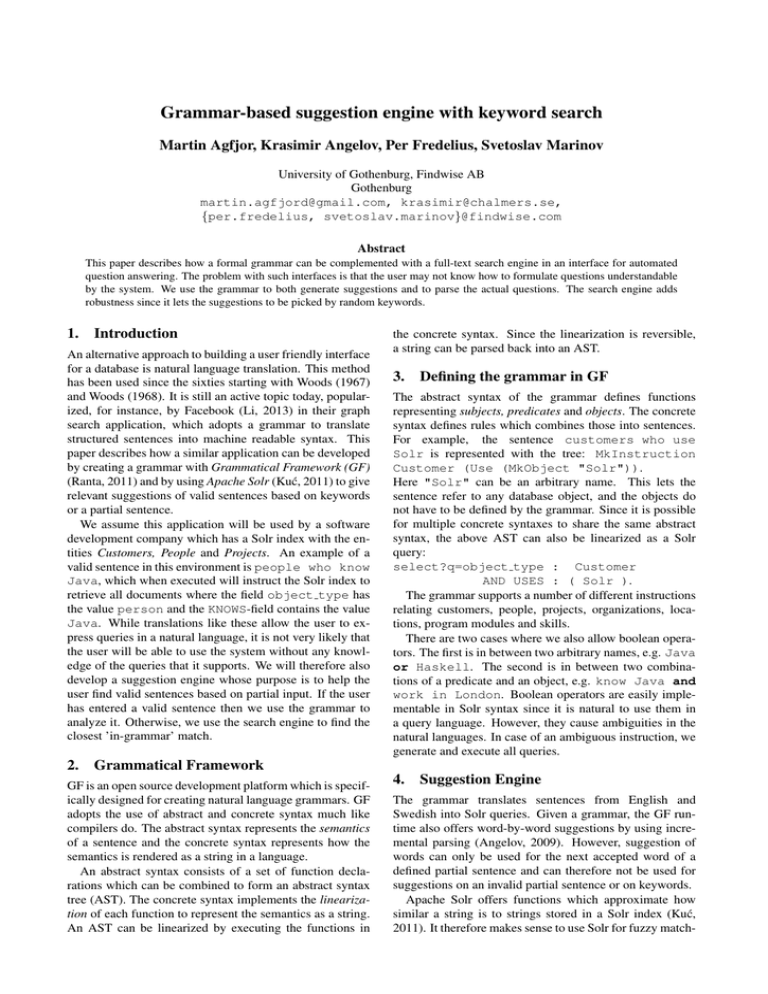
Grammar-based suggestion engine with keyword search
Martin Agfjor, Krasimir Angelov, Per Fredelius, Svetoslav Marinov
University of Gothenburg, Findwise AB
Gothenburg
martin.agfjord@gmail.com, krasimir@chalmers.se,
{per.fredelius, svetoslav.marinov}@findwise.com
Abstract
This paper describes how a formal grammar can be complemented with a full-text search engine in an interface for automated
question answering. The problem with such interfaces is that the user may not know how to formulate questions understandable
by the system. We use the grammar to both generate suggestions and to parse the actual questions. The search engine adds
robustness since it lets the suggestions to be picked by random keywords.
1.
Introduction
An alternative approach to building a user friendly interface
for a database is natural language translation. This method
has been used since the sixties starting with Woods (1967)
and Woods (1968). It is still an active topic today, popularized, for instance, by Facebook (Li, 2013) in their graph
search application, which adopts a grammar to translate
structured sentences into machine readable syntax. This
paper describes how a similar application can be developed
by creating a grammar with Grammatical Framework (GF)
(Ranta, 2011) and by using Apache Solr (Ku´c, 2011) to give
relevant suggestions of valid sentences based on keywords
or a partial sentence.
We assume this application will be used by a software
development company which has a Solr index with the entities Customers, People and Projects. An example of a
valid sentence in this environment is people who know
Java, which when executed will instruct the Solr index to
retrieve all documents where the field object type has
the value person and the KNOWS-field contains the value
Java. While translations like these allow the user to express queries in a natural language, it is not very likely that
the user will be able to use the system without any knowledge of the queries that it supports. We will therefore also
develop a suggestion engine whose purpose is to help the
user find valid sentences based on partial input. If the user
has entered a valid sentence then we use the grammar to
analyze it. Otherwise, we use the search engine to find the
closest ’in-grammar’ match.
2.
the concrete syntax. Since the linearization is reversible,
a string can be parsed back into an AST.
3.
Defining the grammar in GF
The abstract syntax of the grammar defines functions
representing subjects, predicates and objects. The concrete
syntax defines rules which combines those into sentences.
For example, the sentence customers who use
Solr is represented with the tree: MkInstruction
Customer (Use (MkObject "Solr")).
Here "Solr" can be an arbitrary name. This lets the
sentence refer to any database object, and the objects do
not have to be defined by the grammar. Since it is possible
for multiple concrete syntaxes to share the same abstract
syntax, the above AST can also be linearized as a Solr
query:
select?q=object type : Customer
AND USES : ( Solr ).
The grammar supports a number of different instructions
relating customers, people, projects, organizations, locations, program modules and skills.
There are two cases where we also allow boolean operators. The first is in between two arbitrary names, e.g. Java
or Haskell. The second is in between two combinations of a predicate and an object, e.g. know Java and
work in London. Boolean operators are easily implementable in Solr syntax since it is natural to use them in
a query language. However, they cause ambiguities in the
natural languages. In case of an ambiguous instruction, we
generate and execute all queries.
Grammatical Framework
GF is an open source development platform which is specifically designed for creating natural language grammars. GF
adopts the use of abstract and concrete syntax much like
compilers do. The abstract syntax represents the semantics
of a sentence and the concrete syntax represents how the
semantics is rendered as a string in a language.
An abstract syntax consists of a set of function declarations which can be combined to form an abstract syntax
tree (AST). The concrete syntax implements the linearization of each function to represent the semantics as a string.
An AST can be linearized by executing the functions in
4.
Suggestion Engine
The grammar translates sentences from English and
Swedish into Solr queries. Given a grammar, the GF runtime also offers word-by-word suggestions by using incremental parsing (Angelov, 2009). However, suggestion of
words can only be used for the next accepted word of a
defined partial sentence and can therefore not be used for
suggestions on an invalid partial sentence or on keywords.
Apache Solr offers functions which approximate how
similar a string is to strings stored in a Solr index (Ku´c,
2011). It therefore makes sense to use Solr for fuzzy match-
Figure 1: Web interface with suggestions based on the keywords java and london
ing of a partial sentence or set of keywords into natural language sentences defined by the grammar.
4.1 Generation of sentences
GF offers a generator which can do exhaustive generation
of all AST’s for a given syntactic category. We generate all
trees up to a certain depth. The limitation is needed because
we have infinitely many trees due to the recursive boolean
functions. Since the trees also contain arbitrary names,
GF will use "Foo" in an AST when it expects a name.
We will therefore generate AST’s like MkInstruction
People (WorkIn (MkObject "Foo")) which linearizes into people who work in Foo. This linearization will not be very helpful as a suggestion to a user
since Foo is not a location.
A solution is to replace Foo with a relevant name before presenting the suggestion to a user (we assume all
names exists in a separate Solr index). However, as we
treat all names as objects, it would be possible to suggest
many strange sentences to the user, such as people who
work in Haskell.
In order to make distinctions between different names
we introduce name types. A Skill is a programming language, an Organization is an organization,
a Location is a physical location and a Module
is an application module.
The previous AST now
looks like this MkInstruction People (WorkIn
(MkLocation "Foo")). The function MkLocation
reveals that the name in this function is of the type
Location.
The English linearization of the previous AST will however still not contain anything about the type, since the linearization of the AST MkLocation "Foo" is Foo. To
preserve the type of each name, we post-process each AST
and replace "Foo" with the actual type and an index, in
this example "Location0".
4.2 Suggestion retrieval
We generate sentences as described in the previous section
and store them in a Solr index. This section describes how
we take an input from the user and present relevant suggestions based on the input. While the method is rather na¨ıve
and can definitely be improved, it proves very efficient.
We split the input into words and check if each word is
a name by asking the Solr index which contains all names
(and their types). If a word is a name, we replace it in the
input with its type. For example, the sentence people
java will be changed into people Skill0. We fetch
the five most similar sentences from the Solr index by using
Solr’s query interface. In this example, the first result is
the sentence people who know Skill0. Finally, we
change back Skill0 into Java in each sentence.
5.
Conclusions
The results from (Agfjord, 2014) show that this method for
building a natural language interface makes it possible to
translate from natural languages into a query language. We
do not see any limitation with respect to the latter. Thus
any machine readable language could be used instead of
the Solr query syntax.
We found out it was easy to develop a translation service by using GF. It is also easy to extend the grammar
with more sentences. In addition, by mapping ungrammatical sentences into grammatically correct ones we made the
suggestion engine more powerful.
The suggestion engine is fast and scalable, as the Solr
index only needs to store one sentence per AST for each
natural language. This is possible since we only use name
types in the sentences and not actual names. A user can find
relevant sentences by using only keywords. If a keyword is
a name, then the application will recognize the type of the
name and it will correctly use it with appropriate sentences.
Further improvements can be done to the suggestion engine, such as heuristics for which names are relevant if no
names exists in the input. Another optimization is to remove sentences with the same meaning as another sentence
in the index. An example can be seen in Figure 1 where
suggestions 1 and 2 have the same meaning but do not share
the same AST.
The suggestion engine can easily be used together with
speech recognition software. Speech recognition is errorprone when converting spoken input to text string. However, if we use Solr’s built-in string approximation functions we can map the input to the most relevant sentence.
By transforming speech to machine readable syntax we
open up doors to many new applications such as interfaces
for cars and other devices which have limited keyboard interaction.
References
X. Li.
2013.
Under the Hood:
The natural
language interface of Graph Search.
URL:
https://www.facebook.com/notes/facebook-
engineering/under-the-hood-the-natural-languageinterface-of-graph-search/10151432733048920 [Online;
accessed 23-July-2014].
A. Ranta. 2011. Grammatical Framework: Programming
with Multilingual Grammars. CSLI Publications, Stanford. ISBN-10: 1-57586-626-9 (Paper), 1-57586-627-7
(Cloth).
R. Ku´c. 2011. Apache Solr 3.1 cookbook. Packt Publishing. ISBN-13: 978-1849512183 (Paper).
K. Angelov. 2009. Incremental parsing with parallel multiple context- free grammars. European Chapter of the
Association for Computational Linguistics.
M. Agfjord. 2014. Grammar-based suggestion engine with
keyword search. URL: http://thesis.agfjord.se/thesis.pdf
[Online; accessed 28-August-2014].
W. Woods. 1967. Semantics for a Question-Answering
System. Rep. NSF-19. Harvard University Computation
Laboratory, Cambridge, Massachusetts.
W. Woods. 1968. Procedural Semantics for a questionanswering machine. AFIPS. Natl. Comput. Conf. Expo.,
Conference Proceeding 33, 457-471.






